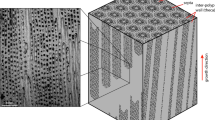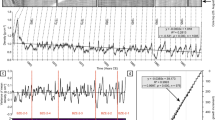Abstract
Micro-scale distributions of trace and minor elements in, for example, coral skeletons are crucial as geochemical tracers of past environmental conditions, because they have the inherent advantage of accounting for confounding diagenetic and physiological effects. To extract reproducible paleoceanographic records from coral skeletons, a selective measurement of specific ultrastructures at high spatial resolution is required. Compared to warm-water reef-building corals, such data are limited in cold-water corals and, to the best of the authors’ knowledge, the latter have to date not been examined by means of micro-X-ray fluorescence. This technique was used for micrometer-scale imaging of P, Mg, Sr, O, and Fe intensities (counts per unit time) in a fossil specimen (as yet unknown age) of the cold-water coral Desmophyllum sp. from surface sediments of the NW Pacific. Cross plots confirmed that the micro-XRF signals were associated with corresponding trends in elemental concentration (ppm). Two major structural components of the septum—centers of calcification (COCs) and the surrounding fibrous aragonite portion—differed in composition. The COCs were characterized by higher intensities of P and Mg (650 and 220 counts per 5 s, respectively), and lower intensities of Sr (2,800) and O (580; corresponding values for the fibrous aragonite are 370, 180, 3,300 and 620 counts per 5 s, respectively). Oxygen intensity values were mostly homogeneous, but slightly lower in COCs and substantially higher in a well-defined patch in the fibrous aragonite. The mostly homogeneous P signals in the fibrous aragonite confirm the utility of this structural component and of coral septa in general for tracer studies of oceanic P. Nevertheless, spot occurrences of elevated P (>950 counts per 5 s) spanning tens of micrometers in specific parts of the fibrous region of the septum would cause overestimates of oceanic P, and should evidently not be overlooked in future research. The distribution of Fe showed no correlation with P, indicating no significant contamination in the form of P-bearing diagenetic ferromanganese precipitates. Such hotspots plausibly reflect the presence of other mineral phases, such as crystalline hydroxylapatite inclusions or contamination with organic material. The P signal intensity was positively correlated with Mg (r=0.553, p<0.001), and negatively with Sr (r=–0.489, p<0.001) and O (r=–0.311, p<0.001). There was no discernible evidence of control by water temperature in the Sr distribution pattern. These findings establish micro-X-ray fluorescence as a highly suitable pre-screening tool in cold-water coral sclerochronology, which can serve to refine sampling strategies without sample damage, and complement other micrometer-scale spatial distribution analyses of elements (notably, Ca) based on well-known approaches involving micro-milling, electron microprobes, secondary ion mass spectrometry, and laser ablation.






Similar content being viewed by others
References
Adkins JF, Cheng H, Boyle EA, Druffel ERM, Edwards RL (1998) Deep-sea coral evidence for rapid change in ventilation of the deep north Atlantic 15,400 years ago. Science 280:725–728
Allison N, Finch AA, Sutton SR, Newville M (2001) Strontium heterogeneity and speciation in coral aragonite: implications for the strontium paleothermometer. Geochim Cosmochim Acta 65:2669–2676
Anagnostou E, Sherrell RM, Gagnon A, LaVigne M, Field MP, McDonough WF (2011) Seawater nutrient and carbonate ion concentrations recorded as P/Ca, Ba/Ca, and U/Ca in the deep-sea coral Desmophyllum dianthus. Geochim Cosmochim Acta 75:2529–2543
Case D, Robinson LF, Auro ME, Gagnon AC (2010) Environmental controls on Mg and Li in deep-sea scleractinian coral. Earth Planet Sci Lett 300:215–225
Cheng H, Adkins J, Edwards RL, Boyle EA (2000) U-Th dating of deep-sea corals. Geochim Cosmochim Acta 64:2401–2416
Cohen AL, Gaetani GA, Lundälv T, Corliss BH, George RY (2006) Compositional variability in a cold-water scleractinian, Lophelia pertusa: new insights into “vital effects”. Geochem Geophys Geosys 12, Q12004. doi:10.1029/2006GC001354
Corrège T (2006) Sea surface temperature and salinity reconstruction from coral geochemical tracers. Palaeogeogr Palaeoclimatol Palaeoecol 232:408–428
Cuif JP, Dauphin Y (2005) The two-step mode of growth in the scleractinian coral skeletons from the micrometre to the overall scale. J Struct Biol 150:319–331
Cuif JP, Dauphin Y, Doucet J, Salome M, Susini J (2003) XANES mapping of organic sulfate in three scleractinian coral skeletons. Geochim Cosmochim Acta 67:75–83
Cuif JP, Dauphin Y, Farre B, Nehrke G, Nouet J, Salomé M (2008) Distribution of sulphated polysaccharides within calcareous biominerals suggests a widely shared two-step crystallization process for the microstructural growth units. Miner Mag 72:233–237
Cuif JP, Dauphin Y, Nehrke G, Nouet J, Perez-Huerta A (2012) Layered growth and crystallization in calcareous biominerals: impact of structural and chemical evidence on two major concepts in invertebrate biomineralization studies. Minerals 2:11–39
Cusack M, Dauphin Y, Cuif JP, Salomé M, Freer A, Yin H (2008a) Micro-XANES mapping of sulphur and its association with magnesium and phosphorus in the shell of the brachiopod, Terebratulina retusa. Chem Geol 253:172–179
Cusack M, Pérez-Huerta A, Janousch M, Finch AA (2008b) Magnesium in the lattice of calcite-shelled brachiopods. Chem Geol 257:59–64
Dauphin Y, Ball AD, Cotte M, Cuif JP, Meibom A, Salomé M, Susini J, Williams CT (2008) Structure and composition of the nacre–prisms transition in the shell of Pinctada margaritifera (Mollusca, Bivalvia). Anal Bioanal Chem 390:1659–1669
Eltgroth SF, Adkins JF, Robinson LF, Southon J, Kashgarian M (2006) A deep-sea coral record of North Atlantic radiocarbon through the Younger Dryas: evidence for intermediate water/deepwater reorganization. Paleoceanography 21, PA4207. doi:10.1029/2005PA001192
Finch AA, Allison N (2008) Mg structural state in coral aragonite and implications for the paleoenvironmental proxy. Geophys Res Lett 35, L08704. doi:10.1029/2008GL033543
Gagan MK, Dunbar GB, Suzuki A (2012) The effect of skeletal mass accumulation in Porites on coral Sr/Ca and δ18O paleothermometry. Paleoceanography 27, PA1203. doi:10.1029/2011PA002215
Gagnon AC, Adkins JF, Fernandez DP, Robinson LF (2007) Sr/Ca and Mg/Ca vital effects correlated with skeletal architecture in a scleractinian deep-sea coral and the role of Rayleigh fractionation. Earth Planet Sci Lett 261:280–295
Hart SR, Cohen AL (1996) An ion probe study of annual cycles of Sr/Ca and other trace elements in corals. Geochim Cosmochim Acta 60:3075–3084
Hayashi E, Suzuki A, Nakamura T, Iwase A, Ishimura T, Iguchi A, Sakai K, Okai T, Inoue M, Araoka D, Murayama S, Kawahata H (2013) Growth-rate influences on coral climate proxies tested by a multiple colony culture experiment. Earth Planet Sci Lett 362:198–206
Inoue M, Suzuki A, Nohara M, Hibino K, Kawahata H (2007) Empirical assessment of coral Sr/Ca and Mg/Ca ratios as climate proxies using colonies grown at different temperatures. Geophys Res Lett 34, L12611. doi:10.1029/2007GL029628
Itaki T, Katayama H, Suzuki A, Kaneko N, Oda H, Arai K (2010) Bottom sediments in west off the Okinawa main Island. In: Arai K (ed) Marine geological and geophysical studies around Okinawa Islands - northwestern off of Okinawa Island - Preliminary Reports on Researches in the 2009 Fiscal Year. GSJ Interim Report no 51, Tsukuba, pp 54–68
LaVigne M, Field MP, Anagnostou E, Grottoli AG, Wellington GM, Sherrell RM (2008) Skeletal P/Ca tracks upwelling in Gulf of Panama coral: evidence for a new seawater phosphate proxy. Geophys Res Lett 35, L05604. doi:10.1029/2007GL031926
LaVigne M, Matthews KA, Grottoli AG, Cobb KM, Anagnostou E, Cabioch G, Sherrell RM (2010) Coral skeleton P/Ca proxy for seawater phosphate: multi-colony calibration with a contemporaneous seawater phosphate record. Geochim Cosmochim Acta 74:1282–1293
Mason HE, Montagna P, Kubista L, Taviani M, McCulloch M, Phillips BL (2011) Phosphate defects and apatite inclusions in coral skeletal aragonite revealed by solid-state NMR spectroscopy. Geochim Cosmochim Acta 75:7446–7457
McConnaughey TA, Gillikin DP (2008) Carbon isotopes in mollusk shell carbonates. Geo-Mar Lett 28:287–299. doi:10.1007/s00367-008-0116-4
Mitsuguchi T, Matsumoto E, Abe O, Uchida T, Isdale PJ (1996) Mg/Ca thermometry in coral skeletons. Science 274:961–963
Montagna P, McCulloch M, Taviani M, Mazzoli C, Vendrell B (2006) Phosphorus in cold-water corals as a proxy for seawater nutrient chemistry. Science 312:1788–1791
Montagna P, McCulloch M, Mazzoli C, Taviani M, Silenzi S (2008) High-resolution geochemical records from Mediterranean cold-water corals: proxies for paleoclimate and paleoenvironmental reconstructions and the role of coral physiology. In: Briand F (ed) CIESM Workshop Monographs no 36. CIESM, Monaco, pp 55–60
Olson IC, Kozdon R, Valley JW, Gilbert PUPA (2012) Mollusk shell nacre ultrastructure correlates with environmental temperature and pressure. J Am Chem Soc 134:7351–7358
Quinn TM, Sampson DE (2002) A multiproxy approach to reconstructing sea surface conditions using coral skeleton geochemistry. Paleoceanography 17:1062. doi:10.1029/2000PA000528
Raddatz J, Liebetrau V, Rüggeberg A, Hathorne E, Krabbenhöft A, Eisenhauer A, Böhm F, Vollstaedt H, Fietzke J, López Correa M, Freiwald A, Dullo WC (2013) Stable Sr-isotope, Sr/Ca, Mg/Ca, Li/Ca and Mg/Li ratios in the scleractinian cold-water coral Lophelia pertusa. Chem Geol 352:143–152
Schöne BR (2008) The curse of physiology—challenges and opportunities in the interpretation of geochemical data from mollusk shells. Geo-Mar Lett 28:269–285. doi:10.1007/s00367-008-0114-6
Schöne BR, Zhang Z, Jacob DE, Gillikin DP, Tütken T, Garbe-Schönberg D, McConnaughey T, Soldati A (2010) Effect of organic matrices on the determination of the trace element chemistry (Mg, Sr, Mg/Ca, Sr/Ca) of aragonitic bivalve shells (Arctica islandica)—Comparison of ICP-OES and LA-ICP-MS data. Geochem J 44:23–37
Schrag DP (1999) Rapid analysis of high-precision Sr/Ca ratios in corals and other marine carbonates. Paleoceanography 14:97–102
Sherwood BA, Sager SL, Holland HD (1987) Phosphorus in foraminiferal sediments from North Atlantic Ridge cores and in pure limestones. Geochim Cosmochim Acta 47:217–233
Shirai K, Kusakabe M, Nakai S, Ishii T, Watanabe T, Hiyagon H, Sano Y (2005) Deep-sea coral geochemistry: implication for the vital effect. Chem Geol 224:212–222
Sinclair DJ, Williams B, Risk M (2006) A biological origin for climate signals in corals - trace element “vital effects” are ubiquitous in Scleractinian coral skeletons. Geophys Res Lett 33, L17707. doi:10.1029/2006GL027183
Smith JE, Risk MJ, Schwarcz HP, McConnaughey TA (1997) Rapid climate change in the North Atlantic during the Younger Dryas recorded by deep-sea corals. Nature 386:818–820
Suzuki A, Ushie H, Shinmen K, Amano A, Kaneko N, Itaki T, Katayama H, Inamura A, Yasuhara M, Yoshinaga Y, Murayama S, Usami T (2010) Geochemical analyses on seawater samples collected during the GH09 cruise in the western offshore of Okinawa Island. In: Arai K (ed) Marine geological and geophysical studies around Okinawa Islands - northwestern off of Okinawa Island - Preliminary Reports on Researches in the 2009 Fiscal Year. GSJ Interim Report no 51, Tsukuba, pp 76–85
Tamenori Y, Ohashi H, Ishiguro E, Ishikawa T (2007) Performance of a grating monochromator at BL27SU beamline of SPring-8 in the higher energy region. Rev Sci Instrum 73:1588–1590
Tamenori Y, Morita M, Nakamura T (2011) Two-dimensional approach to fluorescence yield XANES measurement using a silicon drift detector. J Synchrotron Rad 18:747–752
van de Flierdt T, Robinson LF, Adkins JF, Hemming SR, Goldstein SL (2006) Temporal stability of the neodymium isotope signature of the Holocene to glacial North Atlantic. Paleoceanography 21, PA4102. doi:10.1029/2006PA001294
Wall M, Nehrke G (2012) Reconstructing skeletal fiber arrangement and growth mode in the coral Porites lutea (Cnidaria, Scleractinia): a confocal Raman microscopy study. Biogeosciences 9:4885–4895
Yoshimura T, Tamenori Y, Suzuki A, Nakashima R, Iwasaki N, Hasegawa H, Kawahata H (2013) Element profile and chemical environment of sulfur in a giant clam shell: insights from μ-XRF and X-ray absorption near-edge structure. Chem Geol 352:170–175
Acknowledgements
We express our appreciation to Kosaku Arai and Takuya Itaki of the Geological Survey of Japan (GSJ), AIST for providing coral samples, Yuichiro Tanaka of GSJ and Mana Hikami of AORI for assistance in SEM analysis, and Takashi Toyofuku of JAMSTEC for stereomicroscopy work. Also gratefully acknowledged are Mayuri Inoue of AORI for valuable advice, as well as J. Raddatz, two anonymous reviewers, and the journal editors for insightful and constructive comments. This study was conducted with the approval of the SPring-8 Proposal Review Committee (Proposal 2012A1556 and 2012B1116).
Author information
Authors and Affiliations
Corresponding author
Rights and permissions
About this article
Cite this article
Yoshimura, T., Suzuki, A., Tamenori, Y. et al. Micro-X-ray fluorescence-based comparison of skeletal structure and P, Mg, Sr, O and Fe in a fossil of the cold-water coral Desmophyllum sp., NW Pacific. Geo-Mar Lett 34, 1–9 (2014). https://doi.org/10.1007/s00367-013-0347-x
Received:
Accepted:
Published:
Issue Date:
DOI: https://doi.org/10.1007/s00367-013-0347-x




